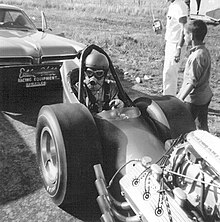Alfa Romeo Tipo 160
The Alfa Romeo Tipo 160, in-plant "P160" (for Progetto / project) was a single-seater that of Alfa Romeo in 1951 for use in the automotive world championship from 1952 was designed. The car was supposed to succeed the successful Tipo 158 and Tipo 159 . However, when Alfa Romeo withdrew from international racing, the vehicle was not used.
background
At the beginning of the 1950s, Alfa Romeo was the dominant team in international motorsport (in 1950 and 1951 , "Nino" Farina and Juan Manuel Fangio were world champions , each in an Alfa Romeo), but came under increasing financial pressure. After an unsuccessful request from Alfa Romeo for government support to cover development costs, the team announced its retirement from Grand Prix racing in late 1951. The Milan-based company now concentrated primarily on the production of series vehicles. At that time, the development of the Tipo 160 was quite advanced, even a prototype already existed. The project, which was first presented with complete sketches on July 13, 1952, was very well received by everyone present, including Juan Manuel Fangio (who was originally supposed to be the driver). In the following years, however, more and more engineers were withdrawn to work on the development of the Giulietta .
technology

The Tipo 160 designed by Giuseppe Busso ( commissioned by Orazio Satta Puliga ) had some revolutionary features for the time. Outwardly, the driver's position is eye-catching: Up until then the sequence engine-driver-tank (as for example with the Tipo 158 ) or driver-tank-engine (see Auto Union Type C ) was the usual scheme, Busso took a new approach: Bei In his concept, the driver sat behind the rear axle, similar to the construction of the American "Slingshot" dragster . The basic idea was to give the driver a better feeling for driving behavior in this position (in the immediate vicinity of the driving rear axle). The tank was installed near the center of the vehicle so that the "handling" hardly changed as the level went down during the race. In addition, the driver had a good view of all four tires and was able to check their condition relatively well.
The all-wheel drive concept was also innovative for a Grand Prix racing car at the time . The front-wheel drive could be switched on or off depending on the route characteristics.
The Tipo 160 was designed for a 180 ° V12 engine installed at the front (i.e. a very flat design) with center output and originally 2000 cm³ displacement, which was shortly afterwards increased to 2500 cm³. The clutch and a central chassis tube with a large diameter were placed directly behind this engine, at the rear end of which gearboxes and the differential were installed in front of the rear axle ( transaxle design). At the front of the engine, the base was cast that held the housing of the front differential. This design made it possible to omit a “traditional” chassis in the form of a ladder or space frame, since the engine, connecting tube and transmission formed the actual backbone of the vehicle, on which the suspension parts were also mounted.
The independent suspension of the front wheels consisted of triangular wishbones with a very wide base mounted on the chassis tube . The springs were longitudinal torsion bars . At the rear, the car had a De-Dion axle with trailing arms that were also attached to the central chassis tube. The two slightly inwardly inclined spring-damper units (coil springs over telescopic dampers ) were very progressive for the time . All wheels had internal drum brakes with cooling fins.
The prototype
Only one “preliminary” prototype of the Tipo 160 was created (more likely to be called a “ test arrangement ”): in autumn 1952, one of the successful Alfetta Tipo 159 ( Fangio's world champion car) was radically converted into a parts carrier. The most important changes concerned the position of the driver's seat, the steering wheel, the pedals and the gears. The small windshield stayed in place. During the first (secret) test runs in Monza , works and test driver Consalvo Sanesi certified that the car was extremely controllable in the corners, and he “already sees this design as the future standard in racing car construction” . This first test resulted in a time of 1 minute 59 seconds and was thus significantly higher than Fangio's time (1 minute 53.4 seconds) with the conventional Tipo 159. Sanesi explained that he drove this time mostly with one hand because he Because of the original, far too far forward and therefore ineffective windshield, I had to hold onto the glasses with the other hand. Another test drive was waived. Due to the simultaneous work on the Giulietta project, the project 160 got more and more delayed. In November 1955, the first bench test for the 12-cylinder engine was carried out ; then came the end. The Giulietta had absolute priority for the future of the brand. There is no reliable information about the whereabouts of the car. The engine with the base for the housing of the front differential, clearly recognizable in the cast block, is exhibited today in the Museo storico Alfa Romeo in Arese .
Web links
- Zwischengas.com Article about the Tipo 160 with detailed plans. Retrieved July 6, 2020
- Alfaromeoregister.org Information on Tipo 160 with picture. Retrieved July 6, 2020
- Jim Stokes workshops Image of the 180 ° V12 engine with the 12 Dell'Orto carburetors during a restoration. Retrieved July 7, 2020


